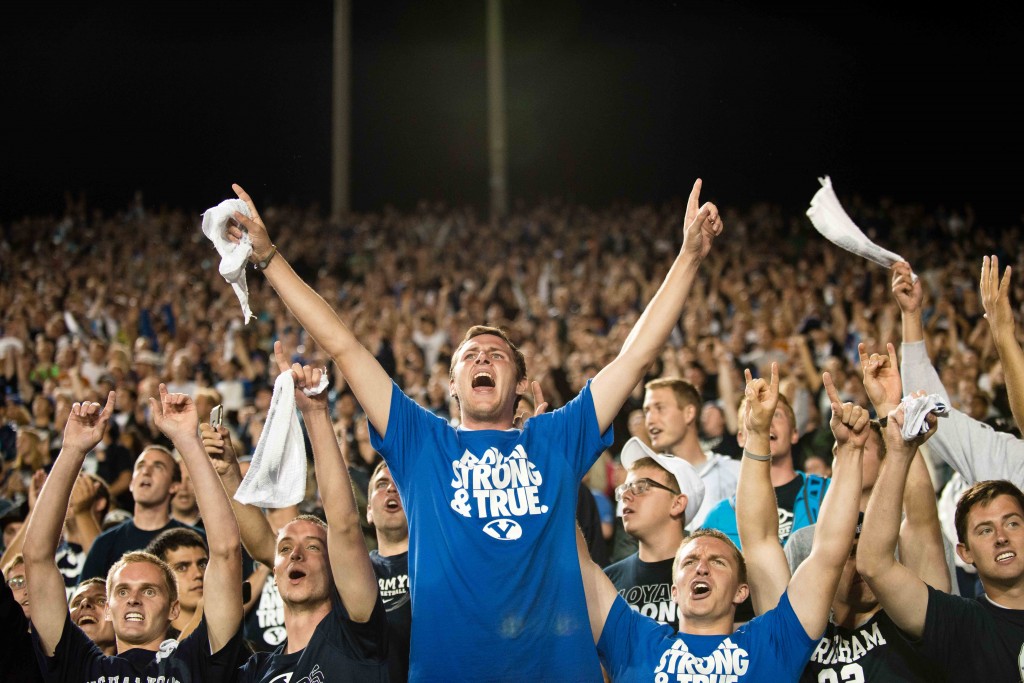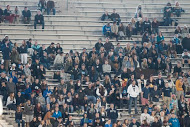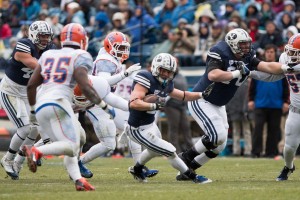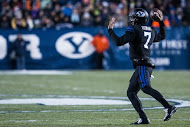
A troubling phenomenon is sweeping across across the college football landscape. A growing number of fans are choosing not to show up to college football games. In 2014, BYU’s LaVell Edwards Stadium experienced the lowest attendance for Cougar football games since the stadium expanded to 65,000 seats in 1982.
Dwindling attendance at football games appears to be an issue that goes far beyond BYU’s specific case. Pockets of empty seats have been seen accumulating in college stadiums, from Corvallis to Columbus to Tallahassee — and almost everywhere in between. According to an Aug. 2014 Wall Street Journal report, the average combined attendance of all FBS games has dropped by 7.1% since 2009.
Several changes over the recent years have contributed to lower attendance at LaVell Edwards Stadium. These include general changes that have affected all NCAA programs, as well as new factors specific to the BYU football program.
General factors for declining attendance
1) Greater accessibility to high-definition telecasts
Before BYU bolted the Mountain West for independence in 2011, they were contractually stuck in a TV deal with “the Mtn.,” the conference’s official flagship network. Accessibility to the Mtn.’s telecasts were limited to those with Comcast Digital Cable, blocking out fans with DirecTV and Dish. The deal proved to be so horrendous that both BYU and Utah school presidents hired broadcasting attorneys to explore any possible opportunity to opt out of the TV contract.
To add insult to injury, the Mtn.’s overall broadcast quality often came into question by irritated fans. The in-stadium viewing experience proved to be far superior to the Mtn.’s telecasts of the games, which didn’t offer high-definition broadcasts until late in the 2008 season.
Compare that with the coverage the Cougars now receive in their current ESPN TV deal, which has seen the “Worldwide Leader” broadcast 21 of the Cougars’ last 25 home games to more than 97 million households across the country. The overall quality of the ESPN broadcasts rank up at the very top, with cutting-edge camera technology allowing for up-close replays and instant analysis, which may have the effect of drawing some fans away from the stadium experience.
“It seems like (for) football, the experience on TV is really good,” BYU student Will Barnard, a senior from Evanston, Wyoming, studying Spanish, said. “You can DVR, you can have HD, good replays, and that’s attractive for a lot of people who, rather than waiting in line for hours, can sit at their apartment and eat food and have a really good viewing experience. So I think that contributes a lot to (declining attendance).”
2) A lack of extensive WiFi available inside stadiums
Currently, LaVell Edwards Stadium is not equipped with a WiFi service system capable of allowing all fans to stay “plugged in” during the games. While that wasn’t much of a problem five years ago, many of today’s younger fans expect to be able to text and tweet and stay active on social media throughout the game.
The University of Baylor recognized this new reality and acted to install a state-of-the-art public WiFi system within its newly built football stadium for the 2014 season. Any relevant program needs to take today’s technological craze in account when seeking to boost attendance, especially among its student body.

BYU-specific factors for declining attendance
1) Team performance
From 2006 to 2009, BYU sold out 18 consecutive games at LaVell Edwards Stadium, going 27-2 at home and 43-9 overall. The Cougars beat in-state rival Utah three out of four years and went a perfect 3-0 against Utah State. The Cougars’ home sellout streak subsequently died at 19 games in 2010, when the team posted a disappointing 7-6 overall record. That season was the beginning of a current five-year stretch, during which the team has gone a combined 41-23 overall, including an 0-4 record against Utah and a 3-2 record against Utah State.
It’s no coincidence that the sellout streak began when the team was winning 10-plus games every year and ended during a 7-6 season. Analyzing BYU’s attendance records from 2009 to 2014 reveals that attendance at LaVell Edwards Stadium drops an average of 2,526 fans in games played the week immediately following a loss.
“I think we all felt (an energy) at LaVell Edwards Stadium this year for the first couple of games,” President of the ROC student section Brian Fagan said. “(We) went out and won a couple of (games) on the road, beat Texas, (there was) lots of hype–Taysom-for-Heisman and all that stuff. The student section was packed for Virginia and for Houston, and the energy in there was unreal; anyone that was in there is feeling it, loving it, no complaints. Then of course it was packed for Utah State, we lost, we end up losing a couple more games, and the next time we came back to LaVell Edwards Stadium the energy wasn’t there anymore. Of course we’re not content with that, and we want the energy to be there regardless of the outcome on the field, but winning helps. Winning helps a lot.”
2) Scheduled opponents
The Cougars’ 2014 home schedule featured three teams from the Mountain West Conference, one from the American Athletic Conference, one from the Atlantic Coast Conference and Savannah State, an FCS team from the Mid-Eastern Athletic Conference. This rather pedestrian slate of opponents combined to finish 25-36 against FBS competition in 2013, and 25-35 in 2014. Attendance slowly gained momentum before reaching its peak against in-state rival Utah State, when 64,090 bought tickets to watch the 4-0 Cougars play in their only rivalry game of the year. After the team lost both the game and star quarterback Taysom Hill, attendance fell sharply to 56,355 against Nevada, 53,622 against UNLV and 52,123 against Savannah State (and the true number may be even lower, since schools “announce” attendance by counting how many people buy tickets to the game, not by how many bodies actually show up).

“The home schedule was not very good this year,” said Taylor Price, a junior from Missoula, Montana, studying public health. “I think (the low attendance) probably had to do with Taysom getting hurt and a lot of the hype around the team fell down. They played some bad games in the middle of the season that a lot of people were disappointed with.”
3) Inception of the ROC
The Roar of Cougars, or “ROC,” is BYU’s version of the student section. The 2013 creation of a section completely devoted to students replaced the old “rotating seat” model that assigned students seats dispersed among season ticket holders, which would then change periodically throughout the year. Currently, students earn their seats based off of a “first come, first served” system.
The change in seating alignment has allowed for the most avid of student Cougar fans to camp out in front of the stadium days before the game in order to ensure getting a front-row seat. While this may have created a greater student presence within the stadium, it has frustrated some who simply aren’t committed enough to wait hours in line to obtain a decent seat. These missing students have created noticeable pockets of empty seats, especially when lumping all students together in one combined section.
“I think that one of (the factors for declining attendance) is (that) it’s such a pain in the butt to go to the games,” said Tyler Bartlett, a sophomore from Sandy, studying Spanish. “You stake out for hours, and us kids are so busy with studying — I mean BYU, it’s really difficult, and so some people just (say), ‘I’m not even going to go.’ Instead of waiting three hours in line they just are like, ‘You know, I’ll watch it on TV.”
Though the ROC’s seating policy may dissuade some students from attending the games, Fagan believes the section has succeeded in its goal of creating a greater home field advantage.
“I think the key here is what the teams think,” Fagan said. “I know from the football players’ and the coaches’ point of view, the atmosphere in LaVell is a lot better the last couple of years than it was before — all things considered. Having a student section that’s all together and 10,000 to 12,000 kids all in one spot screaming is a lot better than mixing them in with season seat holders. For every complaint I’ve heard about people not wanting to have to get there early to get a good seat, there was twenty complaints that someone was upset that every time they stood up and yelled in the end zone, a family behind them said, ‘hey, sit down, we can’t see.’ And for every kid that stood up and started screaming on third down, a person in front of them with their baby said, ‘Hey, can you please be a little more quiet?’ So why not put all the crazy fans in one spot? Every other school in the country does it — because it works.”
4) Weather
BYU’s lucrative television deal with ESPN has resulted in a greater number of Cougar home games slated for evening-or-later starts. While the increase in primetime kickoffs may afford the team greater exposure, it also means that fans attending the games are forced to sit for games with a much colder temperature.

From 2007 to 2010, fans in LaVell Edwards Stadium were subject to three football games with a kickoff time of 5:00 p.m. or later. That changed from 2011 to 2014, when that number jumped to 19 total games with kickoffs at 5:00 p.m. or later. Ten out of those 19 starts took place in October or November, meaning that stadium guests are potentially faced with the prospect of battling freezing temperatures late into the night. While some students and diehard fans are willing to brave the elements, others have stated they would much rather stay at home.
“I would rather watch it at home with friends and not freeze,” said Ashley Mendoza, a senior from Independence, Missouri.
“(The weather plays) some factor, not the deciding factor,” said Ben Ferry, a junior from Brigham City, studying business management. “No one likes to be cold, but I don’t think it would ever really scare me away. As long as you prepare, you’re fine.”
Will BYU be able to address these issues and bring fans back in 2015?
People will have to go to the games to find out.[/vc_column_text][/vc_column][/vc_row]




